
 Mile High Report
Mile High Report
Ever since the Denver Broncos traded away Clinton Portis for Champ Bailey, they have struggled to draft and find an impact player at running back. Will they buck that trend in the 2025 NFL Draft?
A little over twenty years ago, the Denver Broncos shocked the National Football League when they traded running back Clinton Portis to the Washington Redskins in exchange for cornerback Champ Bailey and a second-round pick in the 2004 NFL Draft.
Portis had a productive NFL career with the Redskins, but injuries in 2006, 2009, and 2010 ended up bringing his career to a close after nine seasons. On the other hand, Bailey cemented himself as one of the greatest to ever play the game. A twelve-time Pro-Bowl player and a seven-time All-Pro, Champ was enshrined in the Pro Football Hall of Fame in 2019. The only thing missing from Bailey’s resume was a Super Bowl. Nevertheless, there is no doubt the Broncos came out on the better end of that blockbuster deal.
Since then, the Broncos have struggled to find a long-term solution at running back. In that timeframe, they have utilized thirteen selections in the NFL Draft to bolsterer the position. Seven of them have been either in the first, second, or third round—whilst the other six picks being Day 3 selections. Alas, very few of them made any positive impact in the pros. Moreover, none of them went on to earn second contracts from the franchise. Listed below are those players.
Just seven running backs have eclipsed the 1,000-yard mark for the Broncos since 2004. Phillip Lindsay, who was signed as an undrafted free agent in 2018, was the last running back to accomplish that feat. He did in back-to-back years in 2018 and 2019.
C.J. Anderson, who also went undrafted, did so in 2017. Reuben Droughns, Mike Anderson, and Bell each were able to hit that mark in 2004 through 2006 respectively. The others? Willis McGahee in 2011 and the aforementioned Moreno in 2013.
Thus, only two running backs in the past two decades the Broncos drafted ever hit that mark—Moreno and Bell. While they certainly have gotten productivity from free agent signings and undrafted players, it has virtually been a twenty-year drought at being able to draft a running back who is even moderately effective in the NFL.
This historical reflection is one of the primary reasons...